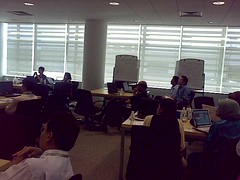I've heard the term "Student-centered Learning" being mentioned a few times during the three-day symposium. I've a better appreciation what the phrase means, now that I read articles like these:
- Student-centred learning: What does it mean for students and lecturers? (n.d.). . Retrieved June 23, 2009, from www.aishe.org/readings/2005-1/oneill-mcmahon-Tues_19th_Oct_SCL.html
- Student-centred learning - Wikipedia, the free encyclopedia. (n.d.). . Retrieved June 23, 2009, from en.wikipedia.org/wiki/Student-centered_learning
Some thoughts about the idea of "Student-centered learning", from my brief encounter with PBL.
WHAT ABOUT 'SLOWER' STUDENTS?
What if an individual student was slower at absorbing the concepts? I asked if there were remedial sessions (for slower students).
Answer was no.
Almost immediately, I realised why: Inherent in PBL is that the onus is on student to buck up. Which also means PBL requires students to have a certain level of maturity and motivation.
STUDENTS CANNOT AFFORD TO DISENGAGE THEMSELVES
In PBL, you're made to work harder as a student. Each student would get to present at some point.
I realised if I didn't force myself to stay engaged (no matter how disinterested I was in the engineering problem) I would not be able to explain when asked to.
In a real class, facilitators would observe students who seem to lag and disengage from the discussion. They can tell who might have problems following the class, from their presentations and responses (or lack of).
STUDENT-LED LEARNING
I think I understand better what is meant by "student-led" learning.
In a sense, the students lead in terms of responses, not necessarily answers. Each team would share their interpretation and rationale. Peers would question/ challenge their peers.

The facilitator said they found student discussions more forthcoming with this approach. I'm not surprised. I think students generally don't want to challenge the teacher whereas the PBL approach creates a more level playing field, so to speak.
The presentation format made the student get used to ideas being challenged. So they are forced to think through before proposing further answers.
I think effective students are honest about what they don't know.
And who would take it upon themselves to reduce that knowledge gap (as opposed to asking teachers to give them the required information).
ONUS IS ON STUDENT TO LEARN
I admitted to the facilitator that I was perhaps hindered by my mental model of what "education" should be. I was expecting to be told what the objective was (e.g. "Linear Programming") and would be happy to be told what it was and how to apply it.
At one point, I wanted to be told what to do.
I wanted to be told how to work on the problem, get on with it, and arrive at a "correct answer". That was how I was schooled for the most part of my student life.
But I realised while that approach was efficient from the "transfer of information" view point, the retention of information was definitely not as long-lasting as the PBL approach.
SUPPORT STRUCTURES
Of course, that does not mean students are left to their own devices. There are facilitators, and there are facilitators who go the extra mile.
One RP academic staff told me his approach was to identify the weaker students (from the tests and various assessments). He would speak to them and he would know if they were really lost. Then he would offer to give more pointers to the students on what to look up and/ or explain the concepts in greater detail.
But again, he admitted the final responsibility was on the student to want to learn.
***
I concluded that for PBL to show results, you really need students who have a certain level of maturity and motivation.
PBL will not motivate the un-motivated.
However, if my experience with the mock PBL lession is anything to go by, PBL is a very effective for students whose process of deriving understanding is best served through an internalisation, 'experiential' and iterative process.
(Twitter hashtag #pbl09w)
[Next: Part 10]

No comments:
Post a Comment
Join the conversation. Leave a comment :)
Note: only a member of this blog may post a comment.